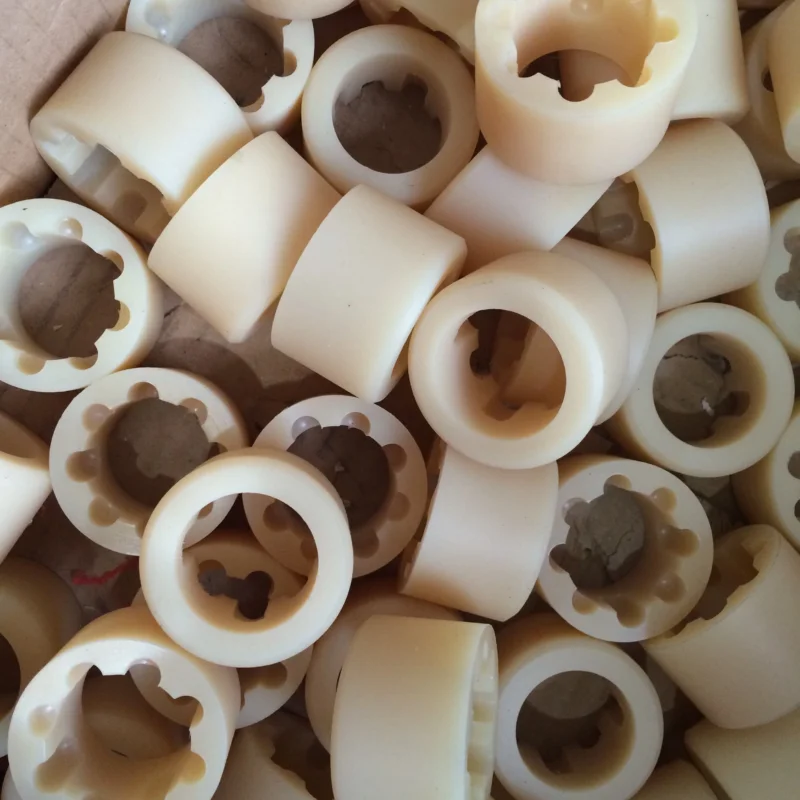JST Industrie
Provides professional CNC plastic machining services
High-Precision Plastics Machining & Processing For Diverse Applications
Plastic materials are favored for CNC machining because of their light weight, cost effectiveness and design flexibility.
Lightweight
The low density of plastics makes them popular for applications that require weight reduction, such as portable electronic devices.
Kosten-Wirksamkeit
Plastic materials are often more economical than metals and are suitable for mass production.
Design Flexibility
Plastics are easy to mold and process, allowing for complex geometries.
Versatile Applications
Plastic materials are used in a variety of industries, including medical, aerospace, electronics and automotive.
Plastic Properties and Applications
JST Industry offers CNC machining services for a wide range of plastic materials to meet the specific needs of different industries with regard to material properties.

Medizinische Geräte
Used in the manufacture of disposable medical devices and diagnostic equipment.

Electronics Industry
Used in the manufacture of housings and insulating components for electronic devices.
Automobilindustrie
For the manufacture of interior trim and some non-structural components.

Transparency
Transparent plastics such as acrylic are used for products that require optical clarity, such as display racks and lamps.

CNC Plastic Machining Parts
Plastic Surface Treatments and Finishing

Painting: Painting services are offered in a variety of colors to meet customers’ individual needs for product appearance.
Überzug: Plating improves the abrasion resistance and electrical conductivity of plastic parts.
Polieren: Provides a smooth touch and high gloss to plastic surfaces.
Laser Engraving: Provide fine marking and customized pattern design.
Fälle von Legierungsbearbeitung und Feedback
Electronics Designer, Shenzhen, China
“When designing a new smartwatch, we chose JST Industry for CNC machining of the plastic case. They not only met our stringent requirements in terms of machining accuracy, but also provided valuable advice on design optimization. The look and feel of the final product exceeded our expectations, thanks in large part to JST Industry’s professional services.”
Unternehmen für medizinische Geräte, Boston, USA
“For our disposable medical devices, JST Industry demonstrated extreme machining precision and a deep understanding of medical-grade plastic materials. Their CNC machining services ensure the consistency and reliability of our products, which is critical for medical applications. In addition, we were impressed with their quick response and flexible production schedule.”
Automotive Interior Supplier, Stuttgart, Germany
“JST Industry’s CNC plastic machining technology provides the precision and sophistication we need in the manufacturing of automotive interior parts. The plastic parts they machine are not only of the highest quality, but also meet an extremely high standard in terms of surface finish, making our interior products more attractive in the marketplace.”
Consumer Electronics Company, Tokyo, Japan
“Our products require the use of specialty plastic materials to meet specific electrical and chemical properties.JST Industry’s expertise and experience in CNC machining of plastics allowed us to quickly transition from the prototype stage to mass production. The quality of their machining and attention to detail have brought our products to a high standard of performance and appearance.”
FAQs
F: Ich entwerfe ein neues Produkt, das eine CNC-Bearbeitung erfordert, um einen Prototyp und ein Endprodukt herzustellen. Wie wähle ich das am besten geeignete Material für die CNC-Bearbeitung für mein Projekt aus?
A: Wir bei JST Industry wissen, dass die Wahl des richtigen CNC-Bearbeitungsmaterials für das Produktdesign entscheidend ist. Sie sollten zunächst das Szenario berücksichtigen, in dem Ihr Produkt eingesetzt werden soll, einschließlich der erforderlichen mechanischen Eigenschaften, Temperaturbeständigkeit, Korrosionsbeständigkeit und Kosteneffizienz. Wir bieten eine breite Palette von Werkstoffen an, unter anderem Aluminiumlegierungen, Edelstahl, Messing, verschiedene Legierungen und viele Kunststoffe. Unser Expertenteam unterstützt Sie bei der Auswahl des für Ihre spezifischen Anforderungen am besten geeigneten Materials und berät Sie bei der Designoptimierung, um einen effizienten und kostengünstigen CNC-Bearbeitungsprozess zu gewährleisten.
Q: Ich würde gerne wissen, wie sich die Auswahl verschiedener Materialien bei der CNC-Bearbeitung auf die endgültigen Bearbeitungskosten auswirkt?
Wir bei JST Industry sind uns bewusst, dass die Materialauswahl einen erheblichen Einfluss auf die Kosten der CNC-Bearbeitung hat. Die Art des Materials, die Schwierigkeit der Bearbeitung und die Marktverfügbarkeit wirken sich alle auf seinen Preis aus. So wird beispielsweise Stahl aufgrund seiner geringeren Kosten häufig verwendet, während Titanlegierungen und bestimmte hochentwickelte Legierungen aufgrund ihrer höheren Materialkosten und Bearbeitungsschwierigkeiten teurer sind. Darüber hinaus wirkt sich auch die Bearbeitbarkeit des Materials auf die Kosten aus, z. B. sind Aluminiumlegierungen aufgrund ihrer leichten Bearbeitbarkeit in der Regel preiswerter. Unser Kostenvoranschlagssystem berücksichtigt all diese Faktoren, damit Sie einen möglichst genauen Kostenvoranschlag erhalten.
Q: Welche Konstruktionsverfahren können mir helfen, die Bearbeitungskosten bei der Konstruktion von CNC-bearbeiteten Teilen zu senken?
F: Ich habe strenge Anforderungen an die Genauigkeit meiner Produkte. Welche Toleranzen können mit CNC-Bearbeitung erreicht werden und wie wirkt sich dies auf die Qualität des Endprodukts aus?
A: Bei JST Industry sind unsere CNC-Bearbeitungsdienste in der Lage, extrem hohe Toleranzen einzuhalten, oft bis zu ±0,01 mm, dank unserer fortschrittlichen Bearbeitungsausrüstung und strengen Qualitätskontrollverfahren. Diese hochpräzise Bearbeitung gewährleistet die Konsistenz und Zuverlässigkeit der Teile, was besonders wichtig für Baugruppen ist, die eine hochpräzise Passung erfordern. Unser Qualitätssicherungssystem umfasst mehrere Prüfungen und Kalibrierungen, um sicherzustellen, dass jedes Teil mit den Konstruktionszeichnungen und Toleranzen des Kunden übereinstimmt und somit die Qualität des Endprodukts gewährleistet ist.





